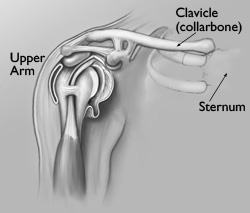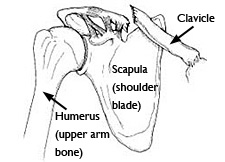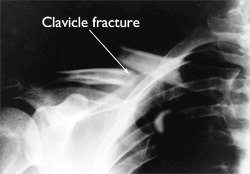
Clavicle Fracture (Broken Collarbone)
A broken collarbone is also known as a clavicle fracture. This is a very common fracture that occurs in people of all ages.
AnatomyThe collarbone (clavicle) is located between the ribcage (sternum) and the shoulder blade (scapula), and it connects the arm to the body.
The clavicle lies above several important nerves and blood vessels. However, these vital structures are rarely injured when the clavicle breaks, even though the bone ends can shift when they are fractured.
 The clavicle is part of your shoulder and connects your ribcage to your arm.
Reproduced from The Body Almanac. (c) American Academy of Orthopaedic Surgeons, 2003.
Description
The clavicle is part of your shoulder and connects your ribcage to your arm.
Reproduced from The Body Almanac. (c) American Academy of Orthopaedic Surgeons, 2003.
Description
The clavicle is a long bone and most breaks occur in the middle of it. Occasionally, the bone will break where it attaches at the ribcage or shoulder blade.
 In this drawing, the fracture is closer to where the clavicle attaches to the shoulder blade.
(Reproduced from Nuber GW, Bowen MK: Acromioclavicular joint injuries and distal clavicle fractures. J Am Acad Orthop Surg 1997;5: 11-18.)
Cause
In this drawing, the fracture is closer to where the clavicle attaches to the shoulder blade.
(Reproduced from Nuber GW, Bowen MK: Acromioclavicular joint injuries and distal clavicle fractures. J Am Acad Orthop Surg 1997;5: 11-18.)
Cause
Clavicle fractures are often caused by a direct blow to the shoulder. This can happen during a fall onto the shoulder or a car collision. A fall onto an outstretched arm can also cause a clavicle fracture. In babies, these fractures can occur during the passage through the birth canal.
SymptomsClavicle fractures can be very painful and may make it hard to move your arm. Additional symptoms include:
- Sagging shoulder (down and forward)
- Inability to lift the arm because of pain
- A grinding sensation if an attempt is made to raise the arm
- A deformity or "bump" over the break
- Bruising, swelling, and/or tenderness over the collarbone
During the evaluation, your doctor will ask questions about the injury and how it occurred. After discussing the injury and your symptoms, your doctor will examine your shoulder.
There is usually an obvious deformity, or "bump," at the fracture site. Gentle pressure over the break will bring about pain. Although a fragment of bone rarely breaks through the skin, it may push the skin into a "tent" formation.
Your doctor will carefully examine your shoulder to make sure that no nerves or blood vessels were damaged.
In order to pinpoint the location and severity of the break, your doctor will order an x-ray. X-rays of the entire shoulder will often be done to check for additional injuries. If other bones are broken, your doctor may order a computed tomography (CT or CAT) scan to see the fractures in better detail.
 This x-ray shows a fracture in the middle of the clavicle. Note how far out of place the broken ends are.
Reproduced with permission from JF Sarwark, ed: Essentials of Musculoskeletal Care, ed 4. Rosemont, IL, American Academy of Orthopaedic Surgeons, 2010.
Nonsurgical Treatment
This x-ray shows a fracture in the middle of the clavicle. Note how far out of place the broken ends are.
Reproduced with permission from JF Sarwark, ed: Essentials of Musculoskeletal Care, ed 4. Rosemont, IL, American Academy of Orthopaedic Surgeons, 2010.
Nonsurgical Treatment
If the broken ends of the bones have not shifted out of place and line up correctly, you may not need surgery. Broken collarbones can heal without surgery.
Arm Support
A simple arm sling or figure-of-eight wrap is usually used for comfort immediately after the break. These are worn to support your arm and help keep it in position while it heals.
Medication
Pain medication, including acetaminophen, can help relieve pain as the fracture heals.
Physical Therapy
While you are wearing the sling, you will likely lose muscle strength in your shoulder. Once your bone begins to heal, the pain will decrease and your doctor may start gentle shoulder and elbow exercises. These exercises will help prevent stiffness and weakness. More strenuous exercises can gradually be started once the fracture is completely healed.
Doctor Follow-Up
You will need to see your doctor regularly until your fracture heals. He or she will examine you and take x-rays to make sure the bone is healing in good position. After the bone has healed, you will be able to gradually return to your normal activities.
Complications
The fracture can move out of place before it heals. It is important to follow up with your doctor as scheduled to make sure the bone stays in position.
If the fracture fragments do move out of place and the bones heal in that position, it is called a "malunion." Treatment for this is determined by how far out of place the bones are and how much this affects your arm movement.
A large bump over the fracture site may develop as the fracture heals. This usually gets smaller over time, but a small bump may remain permanently.
Surgical TreatmentIf your bones are out of place (displaced), your doctor may recommend surgery. Surgery can align the bones exactly and hold them in good position while they heal. This can improve shoulder strength when you have recovered.
Plates and Screws
During this operation, the bone fragments are first repositioned into their normal alignment, and then held in place with special screws and/or by attaching metal plates to the outer surface of the bone.
After surgery, you may notice a small patch of numb skin below the incision. This numbness will become less noticeable with time. Because there is not a lot of fat over the collarbone, you may be able to feel the plate through your skin.
Plates and screws are usually not removed after the bone has healed, unless they are causing discomfort. Problems with the hardware are not common, but sometimes, seatbelts and backpacks can irritate the collarbone area. If this happens, the hardware can be removed after the fracture has healed.
 (A) The clavicle is broken in more than one place and the fragments are severely out of alignment. (B)The fractured pieces are held in place by a combination of plates and screws.
Reproduced with permission from Bahk MS, Kuhn JE, Galatz LM, Connor PM, Williams GR: Acromioclavicular and sternoclavicular injuries and clavicular, glenoid, and scapular fractures. Instructional Course Lectures, Vol. 59. Rosemont, IL, American Academy of Orthopaedic Surgeons, 2010, p 215.
(A) The clavicle is broken in more than one place and the fragments are severely out of alignment. (B)The fractured pieces are held in place by a combination of plates and screws.
Reproduced with permission from Bahk MS, Kuhn JE, Galatz LM, Connor PM, Williams GR: Acromioclavicular and sternoclavicular injuries and clavicular, glenoid, and scapular fractures. Instructional Course Lectures, Vol. 59. Rosemont, IL, American Academy of Orthopaedic Surgeons, 2010, p 215.
Pins
Pins are also used to hold the fracture in good position after the bone ends have been put back in place. The incisions for pin placement are usually smaller than those used for plates. Pins often irritate the skin where they have been inserted and are usually removed once the fracture has healed.
Rehabilitation
Specific exercises will help restore movement and strengthen your shoulder. Your doctor may provide you with a home therapy plan or suggest that you work with a physical therapist.
Therapy programs typically start with gentle motion exercises. Your doctor will gradually add strengthening exercises to your program as your fracture heals.
Although it is a slow process, following your physical therapy plan is an important factor in returning to all the activities you enjoy.
Surgical Complications
People who use any kind of tobacco product, have diabetes, or are elderly are at a higher risk for complications during and after surgery. They are also more likely to have problems with wound and bone healing. Be sure to talk with your doctor about the risks and benefits of surgery for your clavicle fracture.
There are risks associated with any surgery, including:
- Infection
- Bleeding
- Pain
- Blood clots in your leg
- Damage to blood vessels or nerves
- Nausea
The risks specific to surgery for collarbone fractures include:
- Difficulty with bone healing
- Lung injury
- Hardware irritation
Whether your treatment involves surgery or not, it can take several months for your collarbone to heal. It may take longer in diabetics or people who smoke or chew tobacco.
Most people return to regular activities within 3 months of their injury. Your doctor will tell you when your injury is stable enough to do so. Returning to regular activities or lifting with your arm before your doctor advises may cause your fracture fragments to move or your hardware to break. This may require you to start your treatment from the beginning.
Once your fracture has completely healed, you can safely return to sports activities.
What to Discuss With Your Orthopaedic Surgeon- When will I be able to start using my arm?
- When can I return to work?
- Do I have any specific risks for not doing well?
- If I have surgery, what are the risks and benefits and how long will I be in the hospital?
- If I do not have surgery what are the risks and benefits?
- Is my bone weak?
- Should I be taking calcium and Vitamin D?
If you found this article helpful, you may also be interested in Fractures (Broken Bones).
Source: http://orthoinfo.aaos.org/topic.cfm?topic=A00072
